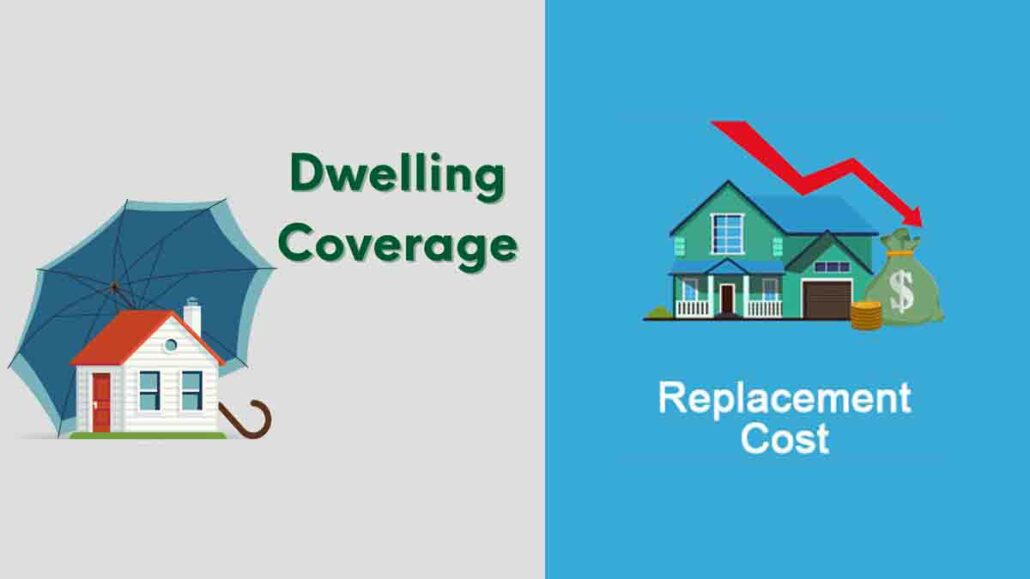Dwelling Coverage vs Replacement Cost. Understanding the nuances of homeowners insurance can be complex. Two crucial terms in this context are “dwelling coverage” and “replacement cost.” Dwelling coverage is essentially the financial protection your homeowner’s insurance policy provides for the structure of your home. It covers the cost of repairing or rebuilding your house in the event of damage caused by covered perils like fire, theft, or natural disasters.

Replacement cost, on the other hand, is the amount of money needed to rebuild your home to its pre-loss condition without deducting for depreciation. This means your insurer will cover the full cost of rebuilding, using materials of similar quality to the original structure. It’s essential to differentiate between these terms to ensure you have adequate coverage for your home and avoid financial burdens in case of unforeseen events.
Dwelling Coverage vs. Replacement Cost
Dwelling Coverage refers to the amount of financial protection your homeowners insurance policy provides to rebuild your home in case of a covered loss, such as a fire or storm. This coverage typically excludes the land your home sits on and personal belongings.
Replacement Cost is the estimated amount needed to rebuild your home to its pre-loss condition using similar materials and quality. This figure differs from the home’s market value, which is what you could potentially sell it for.
Key Differences
| Features | Dwelling Coverage | Replacement Cost |
| Definition | Amount insurer pays to repair or rebuild | Coverage for full rebuild cost without depreciation |
| Cost | Generally, less expensive | Typically, more expensive |
| Coverage | May require additional endorsements | Often included as a policy upgrade |
| Benefit | Protects against underinsurance | Ensure full replacement cost |
Why Replacement Cost Coverage Matters
While dwelling coverage is essential, replacement cost coverage offers superior protection. The cost of construction materials and labor fluctuates over time, and inflation can significantly increase rebuilding costs. Without replacement cost coverage, you might find yourself with insufficient funds to fully restore your home after a disaster.
Consider this scenario: Your home was built 20 years ago for $200,000. Your dwelling coverage is based on the home’s current market value, which might be $300,000. However, the cost to rebuild your home today could be $400,000 due to inflation and increased construction costs. With dwelling coverage, you might receive only $300,000, leaving you with a substantial shortfall. Replacement cost coverage, on the other hand, would provide the full $400,000 to rebuild your home.
The Importance of Replacement Cost Coverage
While dwelling coverage is essential, opting for replacement cost coverage is highly recommended. Here’s why:
- Accurate Valuation: Building costs fluctuate over time. Replacement cost coverage ensures you receive the actual cost of rebuilding, regardless of when the damage occurred.
- Financial Security: Without replacement cost coverage, you might be faced with a shortfall if the cost of rebuilding exceeds your policy limits due to increased construction costs.
- Peace of Mind: Knowing your home is fully protected from unexpected disasters provides significant peace of mind.
Factors Affecting Replacement Cost
Several factors influence the replacement cost of your home:
- Location: Geographic location impacts building costs due to factors like labor, materials, and local regulations.
- Size and Age: Larger homes typically have higher replacement costs, and older homes might require more expensive materials or specialized labor.
- Construction Quality: The quality of materials and workmanship used in your home’s construction affects the rebuilding cost.
- Additional Structures: Attached structures like garages, decks, or patios contribute to the overall replacement cost.
Additional Considerations
- Extended replacement cost coverage: This optional coverage provides additional funds if the cost to rebuild exceeds your dwelling coverage limit.
- Guaranteed replacement cost coverage: Offers even greater protection by guaranteeing to rebuild your home regardless of the cost.
Tips for Determining Adequate Dwelling Coverage
To ensure you have sufficient dwelling coverage:
- Professional Appraisal: Consider getting a professional home appraisal to accurately assess your home’s replacement cost.
- Regular Reviews: Periodically review your policy to account for changes in construction costs and home improvements.
- Consider Inflation: Factor in inflation to ensure your coverage keeps pace with rising building costs.
- Understand Deductibles: Be aware of your policy’s deductible, as it will affect the amount you pay out-of-pocket in case of a claim.
FAQs About Dwelling Coverage and Replacement Cost
What is the difference between dwelling coverage and market value?
Dwelling coverage is the insurance amount protecting your home’s structure, while market value is the potential selling price of your home.
Should I choose dwelling coverage based on the market value of my home?
No, dwelling coverage should be based on the replacement cost of rebuilding your home, not its market value.
Is replacement cost coverage more expensive than actual cash value?
Typically, replacement cost coverage has a slightly higher premium than actual cash value coverage due to the broader protection it offers.
How often should I review my dwelling coverage and replacement cost?
It’s recommended to review your homeowners insurance policy annually, including dwelling coverage and replacement cost, to ensure it aligns with your home’s current value and needs.
What happens if I underinsure my home?
Underinsuring your home can lead to significant financial consequences in case of a loss. You might receive less than the full amount needed to rebuild, leaving you responsible for the shortfall.
Is dwelling coverage the same as market value?
No, dwelling coverage is not the same as market value. Market value is the price you could potentially sell your home for, while dwelling coverage is the amount needed to rebuild your home.
Do I need replacement cost coverage if I have a new home?
Yes, even if you have a new home, replacement cost coverage is essential. Building costs can increase rapidly, and this coverage protects you from potential shortfalls.
What if I make improvements to my home?
It’s crucial to inform your insurance provider about any home improvements or additions. This ensures your coverage is adjusted accordingly to reflect the increased value of your home.
Can I choose between dwelling coverage and replacement cost coverage?
In most cases, you can choose between dwelling coverage and replacement cost coverage. However, replacement cost coverage is generally recommended for better protection.
Conclusion
Understanding the difference between dwelling coverage and replacement cost is vital to protecting your home investment. While dwelling coverage provides basic protection, replacement cost coverage offers comprehensive coverage that can safeguard you from financial hardship in the event of a disaster. By carefully considering your home’s specific characteristics and the potential risks in your area, you can make informed decisions about your homeowners insurance coverage.

